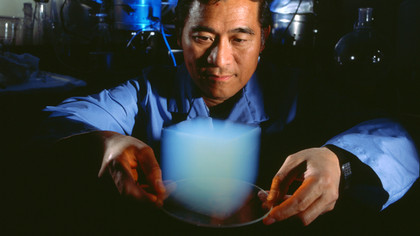Buried within any battery are separators that govern the flow of the cell's electrolyte and electrons. These separators play a crucial structural and functional role within the batteries, meaning we can't simply remove them. However, they are also rigid and inflexible in their current form.
When combined with graphite, nanocellulose conducts electricity while maintaining its strength and flexibility. That means you could, in theory at least, use nanocellulose to create flexible separators, removing one hurdle towards a truly bendable battery.
Of course, you still need a flexible shell around the outside of the cell, but one of our other super-materials can manage that - we wouldn't want graphene to feel left out of the electronics revolution, now would we?
Incredibly strong and light body armour

When you think of body armour, Kevlar probably comes to mind. It's the material most armour not made of plate-steel is constructed with, because the Kevlar fibres knit into a very dense, strong mesh.
Since nanocellulose can be made from incredibly fine fibres too, meshed into a dense crystal lattice in a similar way to Kevlar, it can have a strength-to-weight ratio of up to eight times that of steel.
That makes it the ideal material to construct super-light but incredibly tough body armour, which has the potential to be flexible but still offer good protection.
If you wanted a full-body bullet-proof suit to turn you into a superhero, nanocellulose is what you'd use to make it. In fact, Iron Man could actually be renamed Nanocellulose Man in a couple of years, although it doesn't have quite the same ring to it.
Get daily insight, inspiration and deals in your inbox
Sign up for breaking news, reviews, opinion, top tech deals, and more.
Lighter, faster and more efficient cars
The lighter your car is, the better it will perform. Carbon fibre is the material of choice for high performance cars, but nanocellulose could be the substance to transform our regular cars.
Because nanocellulose is light and strong like carbon fibre, but also cheap to produce with the new algae-based manufacturing methods, it could hold the key to lighter family cars. That'll mean better fuel efficiency and better performing cars, which is both good for the environment and your wallet. In fact, Ford is reportedly already looking into it, meaning your next Fiesta might be even lighter and therefore faster off the mark.
Super-filters and incredible aerogels

As the world gets more and more polluted, finding good ways to filter out the rubbish from our water supply is increasingly important. Nanocellulose can help here too, since its nanoscale crystal lattice can be used to create incredibly fine filters, cheaply.
They can then be used for all sorts of things, from purifying water and blood, or even as chemical filters for things like cigarettes. Nanocellulose could even be used in a desalination technique to rapidly and cheaply produce drinking water from salt water.
If that wasn't enough, because of its strength, nanocellulose can be made into aerogels, or foam, capable of supporting over 10,000 times its own weight, while being incredibly absorbent. It could then be used as super sponges, for anything from wound dressings to water and liquid fuel transport mechanisms. It could even be used to rapidly soak up chemical spills for safe disposal in emergencies.
The beauty of nanocellulose is that, with all these incredible properties, it should be cheap to produce, maintain its strength and structure when wet, and be biodegradable when we're finished with it, making it kind to the planet too.
With so much amazing potential, which we've only scratched the surface of today, that really does make nanocellulose a true super-material.